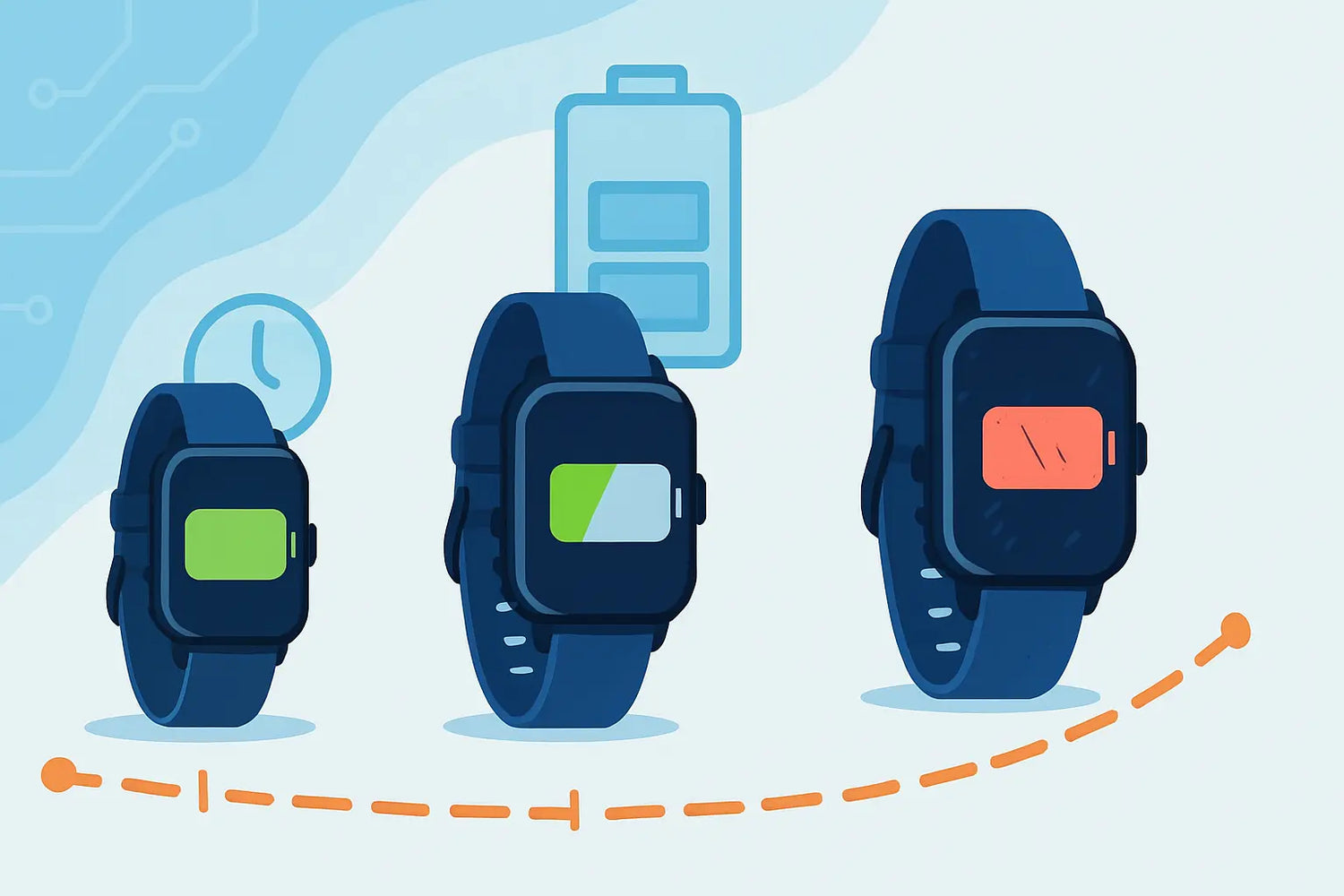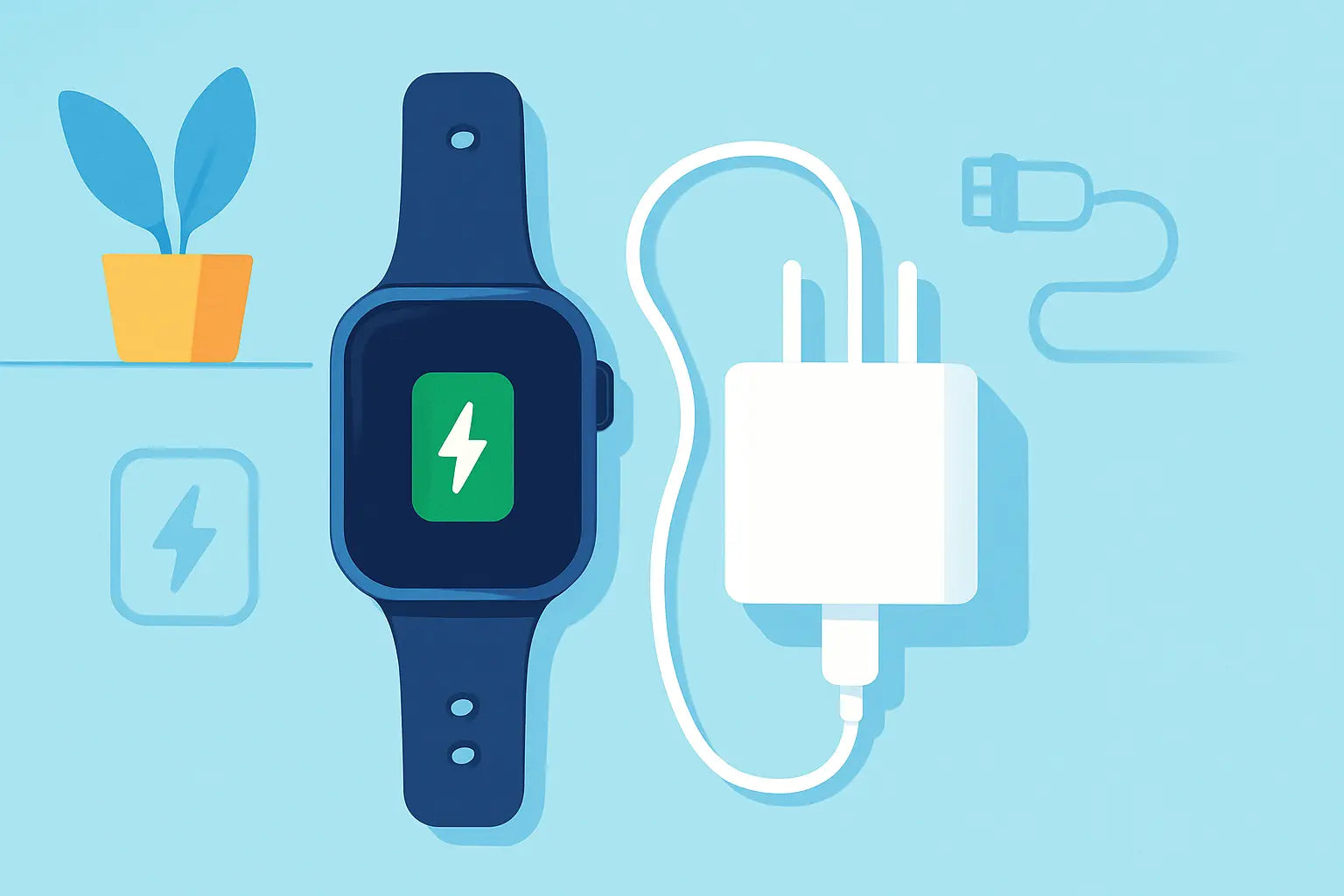Most smartwatches last 3-5 years in everyday use, with batteries typically holding strong for about 2-3 years before noticeable decline. With careful charging and servicing, many reach 5-7 years. Daily runtime per charge ranges from 1-2 days on feature-rich models to 5-14 days on endurance watches.
What determines a smartwatch lifespan?
Longevity depends on three pillars: battery chemistry and cycles, software support, and physical durability. Usage intensity, heat exposure, and repairability add large variation. A well-cared-for watch often outlives its original battery by one replacement cycle.
Apple Watch 11, Samsung Galaxy Watch 8 and Galaxy Watch 9, and premium Garmin models demonstrate this spread clearly. Their design priorities differ, so expected years and per-charge runtimes differ. Understanding the trade-offs helps you plan ownership costs.
Hardware materials and build quality
Aluminum cases are light but show wear sooner than stainless steel or titanium. Displays using sapphire or chemically hardened glass resist scratches better than standard glass. Better sealing and gaskets maintain water resistance longer when rinsed after saltwater and serviced after hard impacts.
Buttons, crowns, haptics, and sensors are generally robust for 4-7 years in normal use. Strap lugs rarely fail when kept clean. Replaceable straps and screen protectors meaningfully extend cosmetic life.
Software and update windows
Operating system support determines feature life and security. Apple Watches commonly receive 5-7 years of watchOS updates, depending on model. Samsung Galaxy Watch lines typically get multi-year Wear OS and security updates, often 3-5 years.
Fitness platforms like Garmin maintain firmware support for long spans, often beyond 5 years for flagship ranges. App ecosystem changes can outpace older hardware, but core tracking remains reliable. When updates stop, functionality continues, yet security and app compatibility may taper.
What’s the battery lifespan of a smartwatch?
Lithium-ion batteries age through charge cycles and time. Most smartwatches are designed to retain about 80 percent of original capacity after roughly 300-500 full cycles. One full cycle equals 100 percent of charge used in total, not necessarily a single 0-100 session.
If you charge daily, you may accumulate around 300-365 cycles per year. That often places meaningful capacity loss around year 2, with steeper decline into year 3. Light users or those charging every other day see slower aging.
Charging habits, heat, and depth of discharge
Heat is the battery’s enemy, so fast charging right after a hot workout accelerates aging. Keeping routine charges roughly in the 20-80 percent band reduces stress. Avoiding repeated 0 percent shutdowns helps cell health.
Nightstand charging at room temperature is ideal. Wireless chargers that misalign can generate heat, so ensure good contact. Occasional full cycles are fine, but daily deep discharges shorten lifespan.
Battery replacement and practical costs
When capacity falls under 80 percent, a replacement restores day-one endurance. Typical out-of-warranty battery service for mainstream smartwatches ranges around 40-110 GBP, depending on brand and model. Third-party services can cost less but may affect water resistance.
Replacing the battery after 2-3 years can extend the total life to 4-6 years or more. Water resistance should be pressure-tested after any service. Keep receipts to maintain resale value.
How long do smartwatches last before battery dies?
Per-charge endurance varies by features and battery capacity. Apple Watch 11 aims for roughly all-day use, often 18-36 hours depending on display settings, LTE, GPS, and Low Power Mode. Samsung Galaxy Watch 8 and 9 typically cover 30-50 hours under mixed use, with always-on display reducing those figures.
Garmin endurance watches commonly achieve 5-14 days in smartwatch mode, longer in battery saver modes. Heavy GPS with music can cut runtimes significantly across all brands. Brightness, notifications, and LTE calls are the biggest drains.
| Model | Typical per-charge time | Capacity drop to 80 percent | Update support estimate | Typical total lifespan |
|---|---|---|---|---|
| Apple Watch 11 | 18-36 hours | 2-3 years | 5-7 years | 4-6 years with service |
| Samsung Galaxy Watch 9 | 30-50 hours | 2-3 years | 3-5 years | 4-6 years with service |
| Samsung Galaxy Watch 8 | 30-50 hours | 2-3 years | 3-5 years | 4-6 years with service |
| Garmin multisport flagship | 5-14 days | 3-4 years | 5-7 years | 5-8 years with service |
Brand snapshots and realistic expectations
Apple Watch 11
Expect polished integration, rapid app performance, and consistent all-day battery. With watchOS updates, features like safety, fitness, and payments stay current for many years. Battery replacement around years 2-3 often restores usefulness to year 5 or beyond.
Water resistance is robust when gaskets are intact. Rinse after pool or sea sessions to protect microphones and speakers. Strap variety keeps comfort and aesthetics fresh for daily wear.
Samsung Galaxy Watch 8 and 9
Galaxy Watch 8 and 9 improve efficiency and often outlast a day on one charge, even with active tracking. Tight Android integration keeps notifications and calls seamless. Wear OS updates and Samsung features roll in for several years.
Battery saver modes and display tweaks extend runtime for travel days. LTE and high-accuracy GPS shorten endurance significantly. Replacement parts and authorized service are widely available in major markets.
Garmin endurance examples
Garmin prioritizes long battery longevity with efficient screens and larger cells. Feature updates for mapping and training tools can span many years. These watches commonly outlast 5 years with minimal degradation if charged less frequently.
For athletes, solar variants may add meaningful standby time in bright conditions. Their per-charge endurance reduces cycle counts per year. That slows chemical aging relative to daily-charge devices.
Care tips that genuinely extend life
Good care adds years and keeps resale high. Clean sensors and rinse after sweat or saltwater to preserve accuracy and seals. Store between 40-60 percent charge if unused for weeks.
- Charge at room temperature
- Avoid 0 percent shutdowns
- Use Low Power Mode
- Keep software updated
- Rinse after saltwater
- Protect the screen
- Swap worn straps
For comfort and hygiene, rotate bands and refresh the look. Explore Apple Watch straps alongside essential Apple Watch accessories to keep your daily setup secure. Quality straps reduce sweat irritation and improve fit for heart rate accuracy.
Signs to repair or replace
Needing multiple daily charges is the clearest battery warning. Random shutdowns above 10 percent charge indicate calibration issues or cell wear. Frequent overheating or sluggish performance also suggests age.
Cracked glass compromises water resistance and safety. If software support ends and security patches stop, consider upgrading. Check trade-in values to offset costs.
Cost of ownership across years
Plan for one battery service within 3 years, plus strap replacements. Screen protectors and cases are inexpensive compared to display repairs. Extended warranties can make sense for LTE models or frequent swimmers.
A practical 5-year plan often costs less than annual upgrades. Servicing at year 2-3 resets endurance and comfort. Reselling after a battery replacement can maximize value retention.
Frequently asked questions
Will a smartwatch last longer if I charge to 80 percent?
Partial charges reduce stress and heat, which helps longevity. Many users see slower degradation by staying roughly in the 20-80 percent range.
How often should I replace a smartwatch battery?
For daily chargers, expect 2-3 years before capacity feels limiting. Light users may reach 3-4 years before service is worthwhile.
Does always-on display significantly reduce lifespan?
It reduces per-charge runtime, increasing charge cycles per year. That can modestly accelerate aging, especially if combined with high brightness and LTE.
Can I swim regularly without shortening life?
Yes, if the watch is water resistant and you rinse after chlorine or saltwater. Periodic gasket checks after impacts are wise.
Do software updates slow older watches?
Occasionally, heavier features can strain aging hardware. However, updates also bring optimizations and security fixes that extend useful life.
Is it better to use official chargers?
Official or certified chargers ensure correct power and alignment. Poor-quality chargers can cause heat or misalignment that ages the battery faster.
Conclusion
A smartwatch typically lasts 3-5 years, and with a midlife battery replacement many reach 5-7 years. Per-charge runtime spans roughly 18-50 hours for Apple Watch 11 and Samsung Galaxy Watch 8 or 9, and several days for endurance Garmins. Careful charging, cleaning, and timely service are the keys to maximum lifespan.




Leave a comment
All comments are moderated before being published.
This site is protected by hCaptcha and the hCaptcha Privacy Policy and Terms of Service apply.